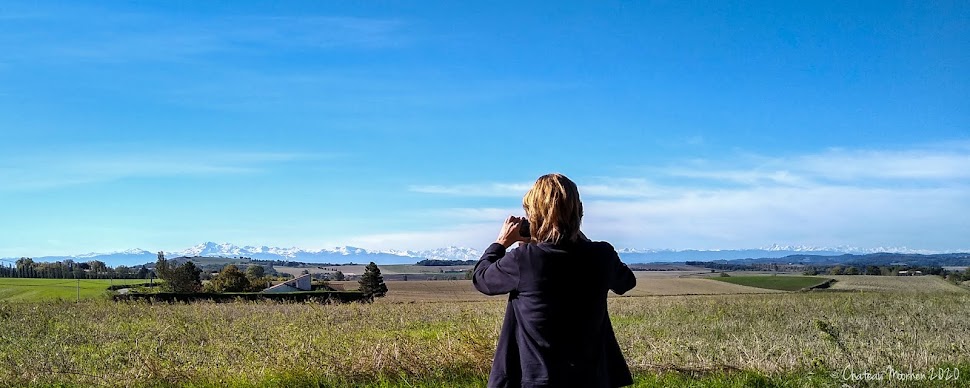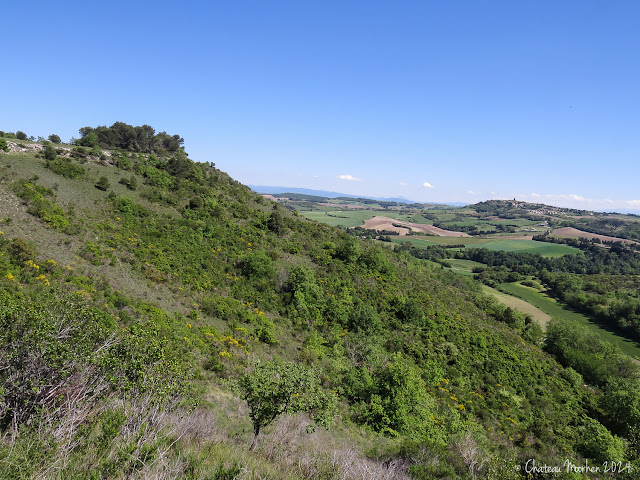Back again! We had a good holiday, but it was somewhat disappointing due to very mixed weather. There were three trips I had planned which involved going up high on either rack railways or a cable car - all three had to be cancelled due to low cloud cover and/or cold wet weather! So our itinerary changed quite a lot, which meant spending my evenings researching other things to do and finding other campsites, which was a pain. It mostly wasn't very good for butterflies either as it seemed that most of the high places had been grazed so there were few flowers about. Finally towards the end of the holiday things looked up and we found Apollo butterflies after over 20 years since our last sighting - and I saw my first Camberwell Beauty!💜💜💜
Since my brother was staying for another 10 days after we returned home, we decided to get out and do a few more touristy things closer to home, when the weather was good.
First up, the Quatre Chateaux de Lastours which is just north of Carcassonne in the Montagne Noir. We had lunch out first in the village then managed to slowly clamber up the fairly rough paths and many steps to three of the ruins. The fourth chateau was over the other side of the hill and involved a lot more walking, so given the heat we decided to call it a day and went back down for a well earned ice cream!
These ruined chateaux are known as Cathar castles - there are many of them in this department. The Cathars were a weird offshoot of the Catholic church and considered heretics, hence the crusades ordered against them by Pope Innocent III to eradicate the movement. There was much bloodshed and atrocities thanks to the likes of Simon de Montfort, 5th Earl of Leicester who became the crusade leader. My own village and all our neighbouring villages and small towns all fell to the crusaders during the early 13th century, some surrendering without a fight.
Many Cathars retreated to castles as the noblemen of the area were sympathetic to their movement, but some of castles were rebuilt or built afresh by the crusaders after Catharism had been mostly eradicated and these castles are referred to as Cathar castles as well. These castles at Lastours were mostly built in the 10th century by the Lords of Cabaret, and after resisting Simon de Montfort's troops for many years, eventually succumbed and were then rebuilt as royal fortresses. So what we see now are not the original Cathar castles.
The Italian Cypresses make for a very scenic looking hillside!
Looking down on the village - the brick chimney is a remnant from when this was an important textile producing town, and the old mill is now the visitor centre.
********
We have been meaning to visit Foix castle for years but never had enough time after coming back from a moho trip with my brother, and we never really fancied it in the winter either when he comes for Xmas. So this was an opportune time.
It's such a delight to park in a town in a car after all the trials and tribulations of trying to find parking in a moho!
Foix is another Cathar castle which sits on a rock above the town, which is the capital of the Ariège department. The castle was constructed around the year 1000 and during the Albigensian crusade against the Cathars it was never taken, despite Simon de Montfort laying seige to it in 1211 and 1212. It was however taken by force by French King Philippe the Bold in 1272. The round tower that you see below was added in the 15th century.
A visit to the museum at the base of the castle is included in the entrance ticket.
Sitting on the bog! Yes, my bum is in a hole, though I am surprised as many latrines in castles that I have seen before were constructed so that waste fell down outside the castle walls.
 |
Romeo, Romeo, wherefore art thou Romeo? |
A trebuchet, a medieval weapon of war, which is a kind of catapault that was a powerful seige engine. This is a small one and most probably a reconstruction.
There was tons of building work going on around the castle making photography very difficult! The castle had just reopened after six months of work so we were somewhat surprised but I guess they wanted the place open for the summer tourist season.
Inside the round tower there were a couple of rooms with old graffiti, some dating from the 18th and 19th centuries. We later learned that it was done by prisoners. Click on the photo to see it larger and you'll see the graffiti scratched in the walls more clearly.
The church of Saint-Volusien, again surrounded by hoardings and building works, hence slightly strange camera angle. This church dates from the 13th C but has been rebuilt several times since then.
Foix was a little disappointing as the medieval section looked anything but! We noted two really old attractive half timbered buildings, but the rest had rendered facades and looked like any other building apart from the colours on the walls and windows.
In home news, before we left we discovered a few baby mantises which had just hatched out of one of our oothecas! The other two oothecas still look the same - even if they had been parasitised, there don't appear to be any holes from anything hatching out. Anyway, the baby mantises were about the size of a large ant. Fabulous to see them so little and cute. We saw another one a few days later but not seen any more, adult or otherwise.
My wasp spiders are back again! I would like to think it is because I moved some of the egg sacs to sheltered places, so they have survived and remain in the garden area. There are four in my Nectar Bar and five in the ditch, of different sizes, but they are all small at the moment and only easy to spot by the zigzag of the stabilimentum.
I also spotted a Large Blue butterfly the other day - I noted all the markings then came in to look in my ID book. No other butterfly that flies in this area has dark markings on its upper wings, and it was larger than the regular size blues we see. We are also having an amazing year for Oregano, which is one of the two host plants (Thyme being the other). They are one of the blue butterflies which are then raised by a particular species of ant after starting life eating the host plant.
As for the bee hotel - we came back from holiday to discover varying sized holes already filled in, and since then there has been non-stop activity. I have watched three bees of different sizes coming backwards and forwards to the holes. There is a yellow and black medium sized bee currently filling in its fourth hole, and yesterday whilst on my hands and knees looking into these holes, a loud buzzing appeared around my head - the poor bee was trying to get into its latest nest hole! It had something white in its mouth, and it has been lining the hole with this white substance. It spent ages in there, moving around inside, presumably smoothing it out, before it starts making the nest chambers. The nest holes are filled in with various materials as well - different coloured dirt, some smoother than others, and some that look like they are covered in a sort of translucent cellophane! It's so thoroughly fascinating and I'm so pleased that the bees have found it, despite it being on the patio!
Thus ends a rather long post from me, but I'm making up for having been quiet for a while. 😀























































